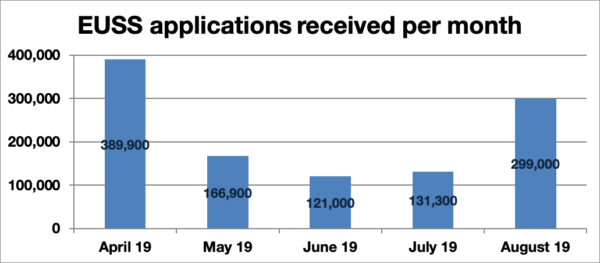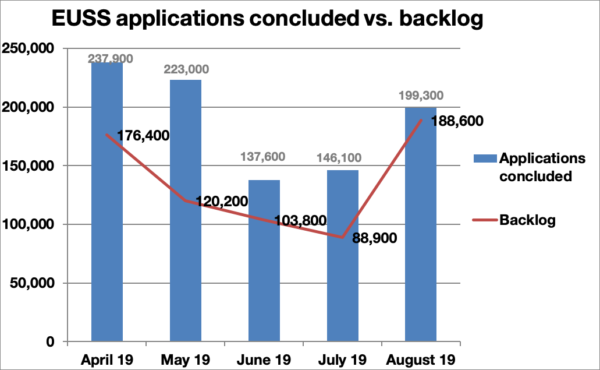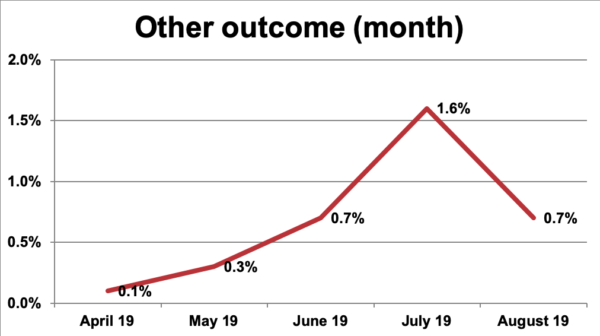- BY Kuba Jablonowski

The good, the bad, and the hard truth buried in EU Settlement Scheme stats: analysis
THANKS FOR READING
Older content is locked

A great deal of time and effort goes into producing the information on Free Movement, become a member of Free Movement to get unlimited access to all articles, and much, much more
TAKE FREE MOVEMENT FURTHER
By becoming a member of Free Movement, you not only support the hard-work that goes into maintaining the website, but get access to premium features;
- Single login for personal use
- FREE downloads of Free Movement ebooks
- Access to all Free Movement blog content
- Access to all our online training materials
- Access to our busy forums
- Downloadable CPD certificates
A few weeks ago I analysed EU Settlement Scheme stats released in August. I argued that the Scheme is not working as well as the Government claims it is. While it might be performing well from the point of view of its administrators at the Home Office, it surely seems to be failing many of its users – namely the EU citizens and their relatives who must apply to it. With the most recent stats release, we learned how the Scheme performed in August. Sadly, things are not looking up.
The volume of applications went up in August, as I predicted it might do following Priti Patel’s statement on ending free movement overnight. This resulted in the second-highest number of applications ever received under the Scheme in a single month. Such an increased uptake may be seen as largely good news, but the spike also created problems within the online system. Multiple reports of technical problems surfaced on social media in the second half of August, and were reported by applicants directly to me and my colleagues at the3million. It does raise the question whether such “boom and bust” approach to encouraging applications is indeed a good one? After all, it is not just immigration status but, by extension, the wellbeing and livelihoods of millions of EU citizens that are at stake.

In fact, the question about the “boom and bust” approach may be partly answered by looking at the numbers of applications concluded. While there was also an increase here, it was not nearly as spectacular as the rise in application volumes. As a result, the backlog of unconcluded applications grew dramatically by 100,000 cases: from around 88,900 at the end of July to 188,600 at the end of August.
The Home Office maintains that “[c]omplete applications are typically being processed within 1 to 4 days.” Even with such a caveated statement, it is clear that something is amiss here. What makes an application atypical? How many such applications are there?
Their number must have been considerable in August, given the dramatic increase of the backlog. The Home Office remains silent on this, while any reassurance would be welcome. In the absence of it, everyone whose application takes more than four days to process is asking themselves: what is wrong with my case?

In what might be good news, the number of applications with “other outcomes” dropped significantly. This is a category defined by the Home Office as “any outcome that did not result in a grant of leave because the application was withdrawn by the applicant, was invalid as it did not include the required proof of identity and nationality or other mandatory information, or was void because the applicant was ineligible to apply.” However, an applicant who recently attempted to withdraw their application told us at the3million that there was a change in the way applications are handled. They used to time out – that is, become invalid – after 70 days, unless applicants completed and submitted them before that deadline. Now it seems they remain active. A clarification is therefore needed to understand whether this decrease is partly driven by a different method of counting cases.

Now, here is some seriously bad news though, and the main reason why it seems the Settlement Scheme is failing an increasing number of those who apply to it. The ratio of settled and pre-settled grants has broadly flatlined at the worrying level of 57% settled to 43% pre-settled. Oxford University’s Migration Observatory estimated that around 69% of EU citizens in the UK have been living here for over five years. Hence, they should be eligible for the more secure settled status – but instead only 56% got that status in July, and 57% in August.

The number of applicants who receive the much inferior pre-settled status (see this graphic for a handy comparison) is an increasingly worrying problem. While the 42% of pre-settled grants in July referred to around 130,000 decisions, the 43% of pre-settled grants in August referred to around 200,000 decisions. This means more and more people end up with pre-settled status each month, and the table below shows this worrying trend.

The Home Office claims the August stats are good news. For some applicants, they really are. But for many – who worry about their applications being stuck in the backlog, or who accept the inferior status despite living in the UK for over five years, and so on – they are bad news indeed. And that’s the hard truth the Home Office needs to face.
And, putting these statistics aside, the hardest truth of all is that no application or registration system in the world has ever reached 100% of its target audience. Therefore, this scheme is heading straight for another Windrush scandal. Only this time it won’t involve citizens who had legal status yet struggled to prove it; it will be about EU citizens who may have lived in the UK for decades, but may soon find themselves without legal status. The only way to avoid this scenario is to turn the application system into a registration system as advocated by the3million, and also explained here on Free Movement.

